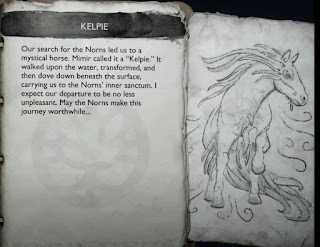why it's called a Kelpie.
In Northern folklore, the water horse attracts, adheres, and drowns those who touch it, but it's never adequately explained why it's called a kelpie. While it's not for certain, it's thought the Scots word's related to the Gaelic "calpa" or colt, but one might instead guess it has to do with kelp.
In the latter line of thinking, God Of War: Ragnarok shows the kelpie with a tail made from strands of kelp, and when it transforms to dive underwater, even more kelp-constructed fins emerge from its body!
Safety warning: Do not be fooled by this GoW:R video -- do not touch a kelpie unless you are able to either put a bridle on it, or if already displaying a bridle, remove it and keep it! Either of these cautionary moves will allow you to control the kelpie.
Guillermo Maytorena IV knew there was something special in the Norse Lore when he picked up a copy of the d'Aulaires' Norse Gods and Giants at age seven. Since then he's been fascinated by the truthful potency of Norse Mythology, passionately read & studied, embraced Ásatrú, launched the Map of Midgard project, and spearheaded the neologism/brand NorsePlay. If you have employment/opportunities in investigative mythology, field research, or product development to offer, do contact him.


Comments
Post a Comment